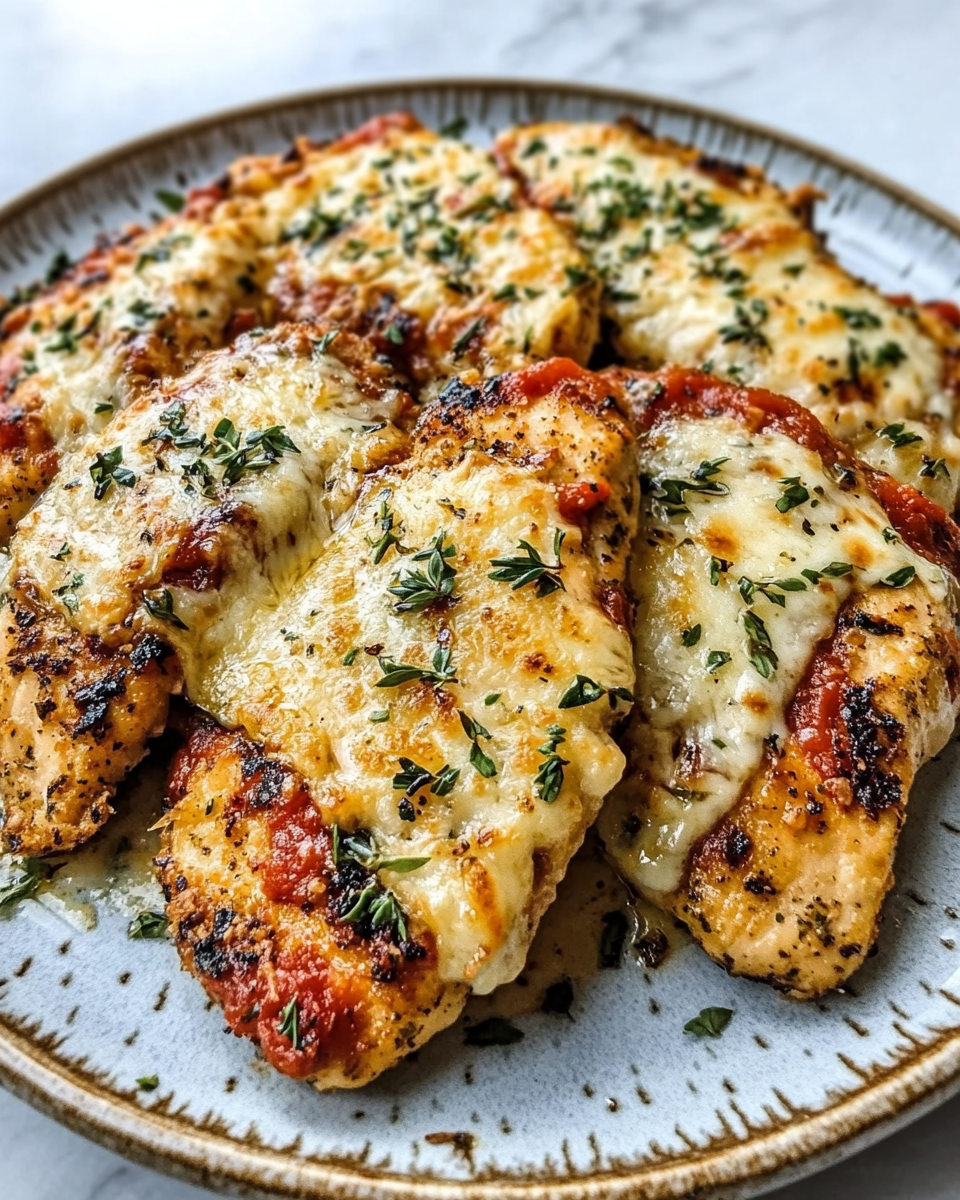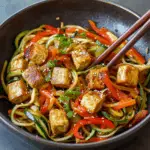A classic Italian-American comfort dish, Chicken Parmesan features crispy breaded chicken breasts topped with rich marinara sauce and melted mozzarella and Parmesan cheeses. It’s perfect served over pasta or with a side salad for a satisfying dinner.
FULL RECIPE
Ingredients
- 2 boneless, skinless chicken breasts
- 1 cup all-purpose flour
- 2 large eggs
- 1 tablespoon water
- 1 cup Italian-style breadcrumbs
- ½ cup grated Parmesan cheese
- 2 cups marinara sauce
- 1½ cups shredded mozzarella cheese
- Salt and black pepper, to taste
- 1 teaspoon garlic powder
- 1 teaspoon dried oregano
- 2 tablespoons olive oil
- Fresh basil for garnish (optional)
- Cooked spaghetti or pasta (optional, for serving)
Directions
- Preheat oven to 400°F (200°C).
- Slice chicken breasts in half horizontally to create 4 thinner cutlets. Season with salt, pepper, garlic powder, and oregano.
- Dredge each cutlet in flour, shaking off excess.
- Beat eggs with water in a shallow bowl. Dip floured chicken in the egg mixture.
- Mix breadcrumbs and Parmesan in another bowl. Coat each chicken piece in the breadcrumb mixture.
- Heat olive oil in a large oven-safe skillet over medium heat. Cook chicken for 3–4 minutes per side until golden and crispy.
- Pour marinara sauce over the chicken in the skillet, then sprinkle with mozzarella cheese.
- Transfer skillet to oven and bake for 15 minutes or until cheese is bubbly and chicken is cooked through.
- Garnish with fresh basil if desired and serve over pasta.
Nutritional Information
- Calories: 500 per serving
- Protein: 40g
- Fat:25g
- Carbohydrates: 30g
- Fiber: 3g
- Sugar: 5g
- Sodium: 900mg
History of Chicken Parmesan
Chicken Parmesan, also known as Chicken Parmigiana, is an Italian-American dish that evolved from traditional Italian recipes. It’s inspired by the classic Italian “Melanzane alla Parmigiana,” which features layers of fried eggplant, marinara, and cheese. Italian immigrants in the United States adapted the dish using chicken instead of eggplant to create a heartier, protein-rich meal that became popular in Italian-American households and restaurants.
Cultural Significance
Chicken Parmesan holds a special place in Italian-American cuisine and is often associated with family gatherings and celebrations. It embodies the blending of Old World tradition with New World ingredients and preferences. The dish’s comforting and hearty nature has made it a staple for many, symbolizing home cooking and Italian heritage.
Flavor Profile
The flavor of Chicken Parmesan combines several key elements: the crispy, seasoned breadcrumb coating; the savory and tangy marinara sauce; the creamy, melted mozzarella cheese; and the sharp, nutty Parmesan. The seasoning on the chicken itself often includes garlic, oregano, and pepper, which add depth and enhance the overall taste experience.
Texture and Mouthfeel
The dish offers a pleasing contrast of textures. The breaded chicken has a crispy, golden exterior with a juicy, tender interior. The melted cheese on top provides a gooey, creamy layer, while the marinara sauce adds a smooth, slightly acidic component that balances the richness of the cheese and chicken.
Variations Across Regions
While the basic concept remains the same, Chicken Parmesan can vary by region and household. Some versions use different cheeses like provolone or fontina. Others may add herbs like basil or parsley in the breadcrumb coating or substitute the traditional marinara with a spicier or sweeter sauce. There are also baked versus fried versions, depending on preference and cooking style.
Health Considerations
Chicken Parmesan is a flavorful dish but can be relatively high in calories, fat, and sodium due to the frying process, cheese, and sauce. For a healthier version, some people opt for baking the chicken instead of frying, using low-fat cheese, or making their own marinara sauce with less added sugar and salt. Balancing it with a side of vegetables or salad can make the meal more nutritious.
Nutritional Benefits
Despite some drawbacks, Chicken Parmesan provides a good source of protein from the chicken, which supports muscle repair and growth. The tomato-based marinara sauce is rich in antioxidants like lycopene, which have health benefits. Parmesan cheese, in moderation, adds calcium and essential vitamins, contributing to bone health.
Cooking Techniques
The key to a great Chicken Parmesan is mastering the breading and frying technique. Dredging the chicken in flour, egg, and seasoned breadcrumbs creates a crispy crust that locks in moisture. Frying at the right temperature is crucial to avoid greasy or soggy chicken. Baking the assembled dish finishes cooking the chicken thoroughly and melts the cheese perfectly.
Common Mistakes to Avoid
Overcooking the chicken can dry it out, while undercooking is unsafe and unpleasant. Not seasoning the flour or breadcrumbs well can result in a bland crust. Using too much sauce may make the breading soggy, and adding cheese too early can cause it to burn in the oven. Proper timing and temperature control are essential for success.
Serving Suggestions
Chicken Parmesan pairs wonderfully with spaghetti or other pasta types, allowing the sauce to complement the noodles. It also goes well with steamed vegetables, a crisp green salad, or garlic bread. For a low-carb option, it can be served alongside roasted vegetables or cauliflower rice.
Wine Pairings
Classic wine pairings for Chicken Parmesan include medium-bodied reds like Chianti, Sangiovese, or Merlot. These wines have enough acidity to balance the tomato sauce and enough body to stand up to the richness of the cheese and chicken. For white wine lovers, a fuller-bodied Chardonnay or a dry Italian white can also complement the flavors.
Making It Ahead
Chicken Parmesan can be prepared ahead of time by breading and frying the chicken, then assembling it in a baking dish and refrigerating until ready to bake. This makes it convenient for busy weeknights or entertaining guests. Reheat gently in the oven to maintain the crispiness and avoid sogginess.
Freezing and Storage
Leftover Chicken Parmesan can be stored in an airtight container in the refrigerator for up to three days. For longer storage, freezing is an option. Wrap individual portions tightly in plastic wrap and foil before freezing. To reheat, thaw overnight in the fridge and bake in the oven until heated through.
Gluten-Free Adaptations
For those with gluten sensitivities, substitute traditional breadcrumbs with gluten-free breadcrumbs or crushed gluten-free crackers. Make sure the flour used for dredging is also gluten-free, such as rice or almond flour. These substitutions maintain the dish’s texture and flavor while accommodating dietary needs.
Vegan and Vegetarian Versions
Vegetarian adaptations often replace the chicken with eggplant or large portobello mushrooms, breaded and prepared similarly. Vegan versions use plant-based cheeses and egg substitutes for breading. These alternatives offer similar flavor profiles and textures for those avoiding animal products.
Pairing with Side Dishes
Besides pasta, Chicken Parmesan pairs well with various sides like sautéed spinach, roasted Brussels sprouts, or a fresh tomato and mozzarella salad. These sides add freshness and balance to the meal, enhancing both flavor and nutrition.
Role in Popular Culture
Chicken Parmesan has appeared in numerous movies, TV shows, and cookbooks as a symbol of Italian-American cuisine. Its comforting appeal and recognizable presentation have made it a favorite dish featured in both casual and fine dining settings.
Tips for Perfect Breadcrumb Coating
Using fresh breadcrumbs or Italian-seasoned ones elevates the flavor. Adding grated Parmesan cheese to the breadcrumbs increases the crust’s richness. Lightly pressing the coating onto the chicken helps it adhere better during cooking, resulting in a uniform, crispy exterior.
How to Make Homemade Marinara Sauce
Homemade marinara sauce can be made by simmering crushed tomatoes with garlic, onions, olive oil, and fresh herbs like basil and oregano. Cooking it slowly allows the flavors to meld and develop depth. This fresh sauce can be tailored to personal tastes, avoiding added sugars and preservatives common in store-bought versions.
Cheese Choices and Their Effects
Mozzarella is the classic cheese for melting over Chicken Parmesan due to its mild flavor and creamy texture. Parmesan adds a salty, nutty bite. Some cooks experiment with provolone or fontina to introduce different textures and flavors. The choice of cheese affects both taste and how the dish melts and browns in the oven.
Conclusion
Chicken Parmesan is a beloved dish that balances rich flavors and textures, combining crispy breaded chicken with savory marinara sauce and melted cheese. Its roots in Italian-American cuisine and adaptability have helped it become a household classic. Whether served with pasta, vegetables, or on its own, it offers a satisfying meal that can be customized to suit various dietary needs and preferences. Mastering the cooking techniques and understanding the elements that make this dish special ensures a delicious outcome every time.






